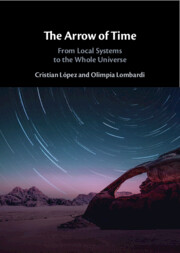Book contents
- The Arrow of Time
- The Arrow of Time
- Copyright page
- Contents
- Contributors
- Preface
- Acknowledgments
- Part I Local Systems
- Part II The Arrow of Time and Philosophical Issues
- Part III The Arrow of Time and Time-Reversal Invariance
- 8 Time for Pancakes: Time Reversal and Ontology
- 9 Insights into Quantum Time Reversal from the Classical Schrödinger Equation
- 10 Saving the Appearances: The Direction of Time and Time-Reversal Invariance
- Part IV The Whole Universe
- Index
- References
10 - Saving the Appearances: The Direction of Time and Time-Reversal Invariance
from Part III - The Arrow of Time and Time-Reversal Invariance
Published online by Cambridge University Press: 28 October 2025
- The Arrow of Time
- The Arrow of Time
- Copyright page
- Contents
- Contributors
- Preface
- Acknowledgments
- Part I Local Systems
- Part II The Arrow of Time and Philosophical Issues
- Part III The Arrow of Time and Time-Reversal Invariance
- 8 Time for Pancakes: Time Reversal and Ontology
- 9 Insights into Quantum Time Reversal from the Classical Schrödinger Equation
- 10 Saving the Appearances: The Direction of Time and Time-Reversal Invariance
- Part IV The Whole Universe
- Index
- References
Summary
In this chapter, I endorse phenomenal conservatism as an epistemic theory of justification and I defend that we are justified in believing that the direction of time is primitive because it seems to us to be primitive, unless there were defeaters for having such a belief. This is what I call the “Argument From Appearances.” I then analyse one of the most powerful arguments against this argument, the “Time-Reversal Argument,” and claim that it relies on supplementary premises that can be challenged. Therefore, it is rendered harmless and does not qualify as a solid defeater against the Argument from Appearances.
Information
- Type
- Chapter
- Information
- The Arrow of TimeFrom Local Systems to the Whole Universe, pp. 198 - 222Publisher: Cambridge University PressPrint publication year: 2025
References
Accessibility standard: WCAG 2.1 AA
Why this information is here
This section outlines the accessibility features of this content - including support for screen readers, full keyboard navigation and high-contrast display options. This may not be relevant for you.Accessibility Information
Content Navigation
Allows you to navigate directly to chapters, sections, or non‐text items through a linked table of contents, reducing the need for extensive scrolling.
Provides an interactive index, letting you go straight to where a term or subject appears in the text without manual searching.
Reading Order & Textual Equivalents
You will encounter all content (including footnotes, captions, etc.) in a clear, sequential flow, making it easier to follow with assistive tools like screen readers.
You get concise descriptions (for images, charts, or media clips), ensuring you do not miss crucial information when visual or audio elements are not accessible.
Visual Accessibility
You will still understand key ideas or prompts without relying solely on colour, which is especially helpful if you have colour vision deficiencies.
Structural and Technical Features
You gain clarity from ARIA (Accessible Rich Internet Applications) roles and attributes, as they help assistive technologies interpret how each part of the content functions.
